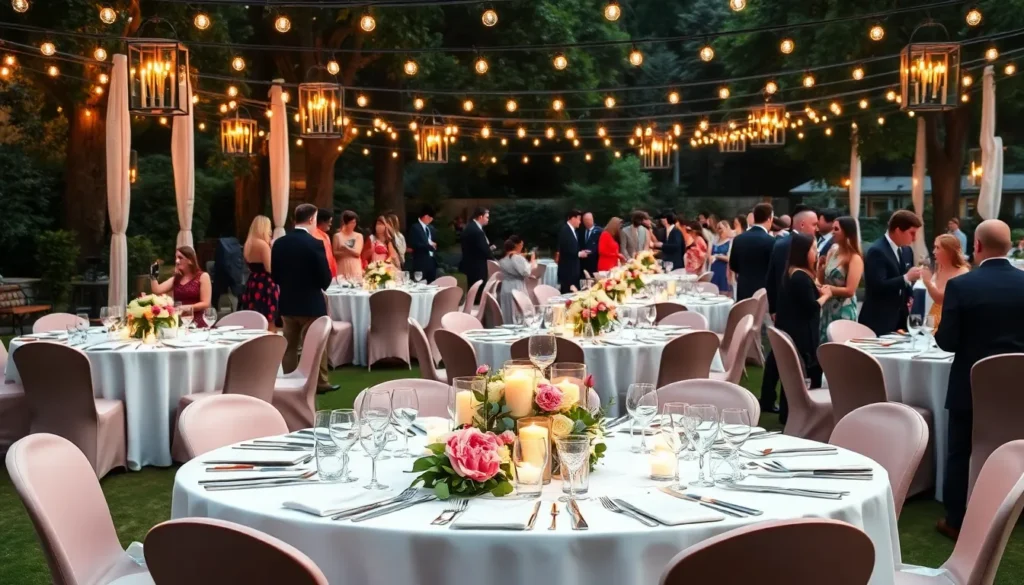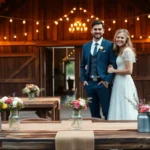Planning the perfect wedding reception means getting every detail right – and your table layout can make or break the entire experience. We’ve all been to weddings where guests struggled to see the couple or felt isolated at awkwardly placed tables. The right seating arrangement creates natural conversation flow while ensuring everyone feels included in your special celebration.
Your table layout directly impacts how guests interact with each other and enjoy the festivities. Whether you’re working with a grand ballroom or an intimate garden space we’ll show you how to maximize your venue’s potential. Smart positioning creates better sightlines for speeches helps with efficient service and encourages mingling between different groups.
From classic round table arrangements to trendy long farmhouse styles we’ve gathered the most effective layout strategies that work for any wedding size or budget. These proven ideas will transform your reception space into a welcoming environment where memories are made and everyone has an unforgettable time.
Round Table Wedding Layouts for Intimate Conversations
Round tables naturally create cozy conversation circles that bring guests together effortlessly. We’ve found these layouts work exceptionally well for fostering meaningful connections throughout your reception.
Classic Round Table Arrangements
Standard 60-inch round tables accommodate 8-10 guests comfortably while maintaining intimate conversation flow. We recommend spacing tables 6-8 feet apart to allow easy movement for servers and dancing guests. Position each table strategically so every guest has clear sightlines to the head table or ceremony backdrop.
Uniform table sizing creates visual harmony across your reception space while ensuring consistent guest experiences. We suggest using linens that complement your venue’s architecture, whether that’s elegant ivory for ballrooms or rustic burlap for garden settings. Chair placement should alternate male and female guests when possible to encourage mingling between different social circles.
Central floral arrangements work best when kept low (under 14 inches) to avoid blocking conversations across the table. We’ve seen couples successfully use candles, succulents, or scattered petals as cost-effective alternatives that maintain the intimate atmosphere round tables naturally provide.
Mixed Round Table Sizes for Visual Interest
Combining 48-inch and 60-inch round tables adds ever-changing visual appeal while serving different group sizes effectively. We place smaller tables near the dance floor for high-energy guests and larger ones in quieter areas for families with children or elderly relatives.
Staggered heights using cocktail tables alongside standard rounds create conversation variety throughout your reception space. We recommend no more than three different table sizes to maintain cohesive flow while adding the visual interest you’re seeking.
Strategic guest placement becomes crucial when mixing table sizes since smaller rounds accommodate 6 guests while standard ones seat 8-10. We assign close-knit friend groups to smaller tables and extended family or work colleagues to larger ones where conversation can flow more naturally among acquaintances.
Round Table Focal Point Positioning
Sweetheart table placement works beautifully when surrounded by round guest tables in a semicircle formation. We position your special table slightly elevated or with enhanced lighting to create a natural focal point while keeping you connected to your guests.
Dance floor integration places round tables in curved lines that naturally guide guests toward the celebration’s center. We avoid rigid geometric patterns, instead creating organic flow that encourages movement between tables and onto the dance floor throughout the evening.
Architectural feature enhancement uses round tables to complement your venue’s existing focal points like fireplaces, windows, or gardens. We arrange tables in gentle arcs that draw attention to these features while ensuring every guest feels included in the celebration’s main events.
Long Banquet Style Table Configurations
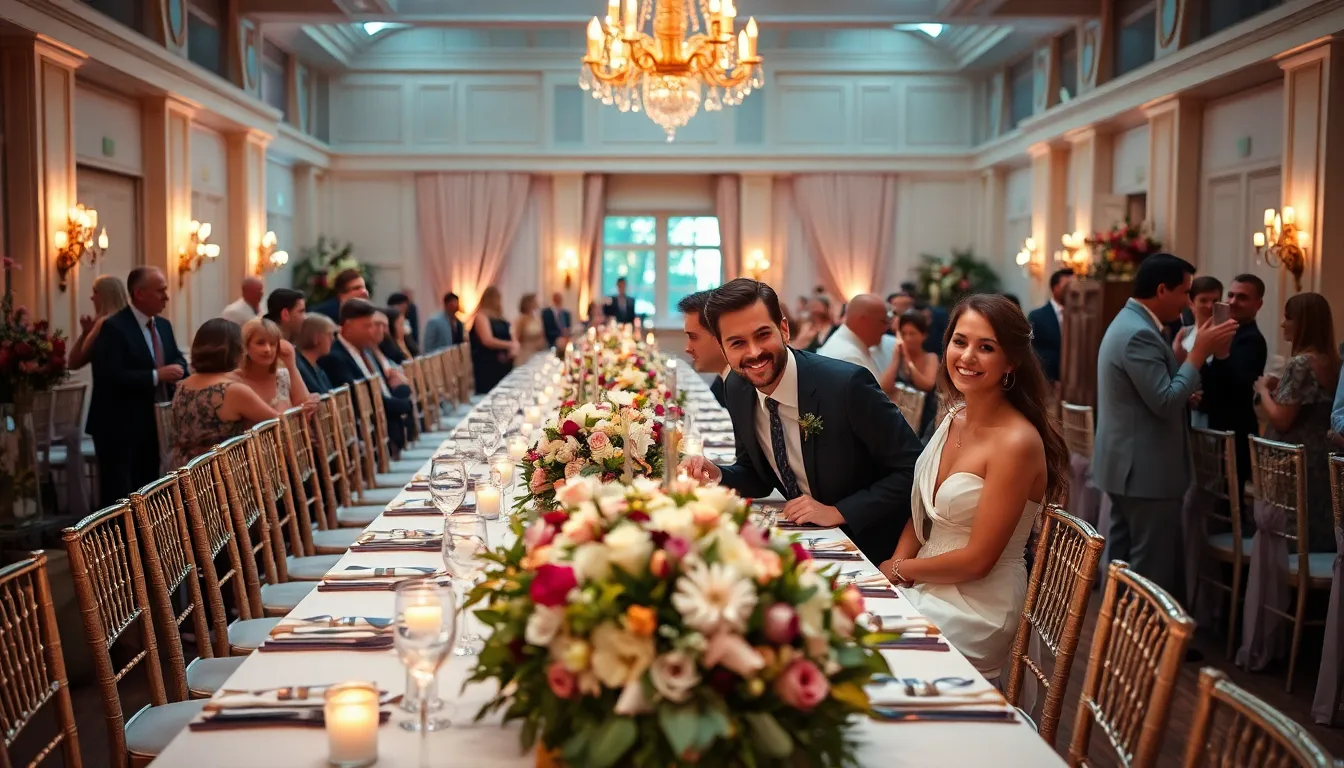
Long banquet style tables create a completely different atmosphere than round table arrangements. These linear configurations transform your reception space into an elegant dining experience that encourages connection and conversation.
Single Long Table for Smaller Weddings
Single long rectangular tables work perfectly for intimate weddings with fewer than 40 guests. This setup naturally encourages conversation across the entire table while fostering a sense of closeness among your loved ones. Couples often choose this arrangement for rehearsal dinners or small receptions where they want to remain at the center of attention.
Decorating these tables becomes an opportunity to create impressive visual impact. We recommend using table runners, strategically placed candles, or flowing floral arrangements to enhance the elegant aesthetic. The linear design allows for creative centerpiece displays that draw the eye down the entire length of the table.
Multiple Parallel Long Tables
Multiple long tables arranged in parallel rows accommodate larger guest counts while maintaining that coveted banquet atmosphere. This configuration works exceptionally well in spacious venues where you need to seat more guests without sacrificing the intimate feel of family style dining.
Arranging tables in neat parallel rows facilitates smooth guest flow throughout your reception space. Everyone maintains clear sightlines to key areas like the dance floor or sweetheart table, ensuring no one feels disconnected from the celebration. This layout proves especially effective in rectangular venues where the space naturally supports linear arrangements.
Feasting Style Community Tables
Feasting or family style community tables focus entirely on encouraging interaction and sharing among your guests. Long tables are set with large platters of food, allowing guests to serve themselves and their neighbors in a communal dining experience. This style creates a convivial atmosphere that brings people together over shared meals.
Community tables work beautifully when you want to break down social barriers and encourage mingling between different guest groups. The shared serving style naturally creates conversation starters and helps shy guests feel more comfortable captivating with others at their table.
U-Shaped Table Arrangements for Interactive Dining
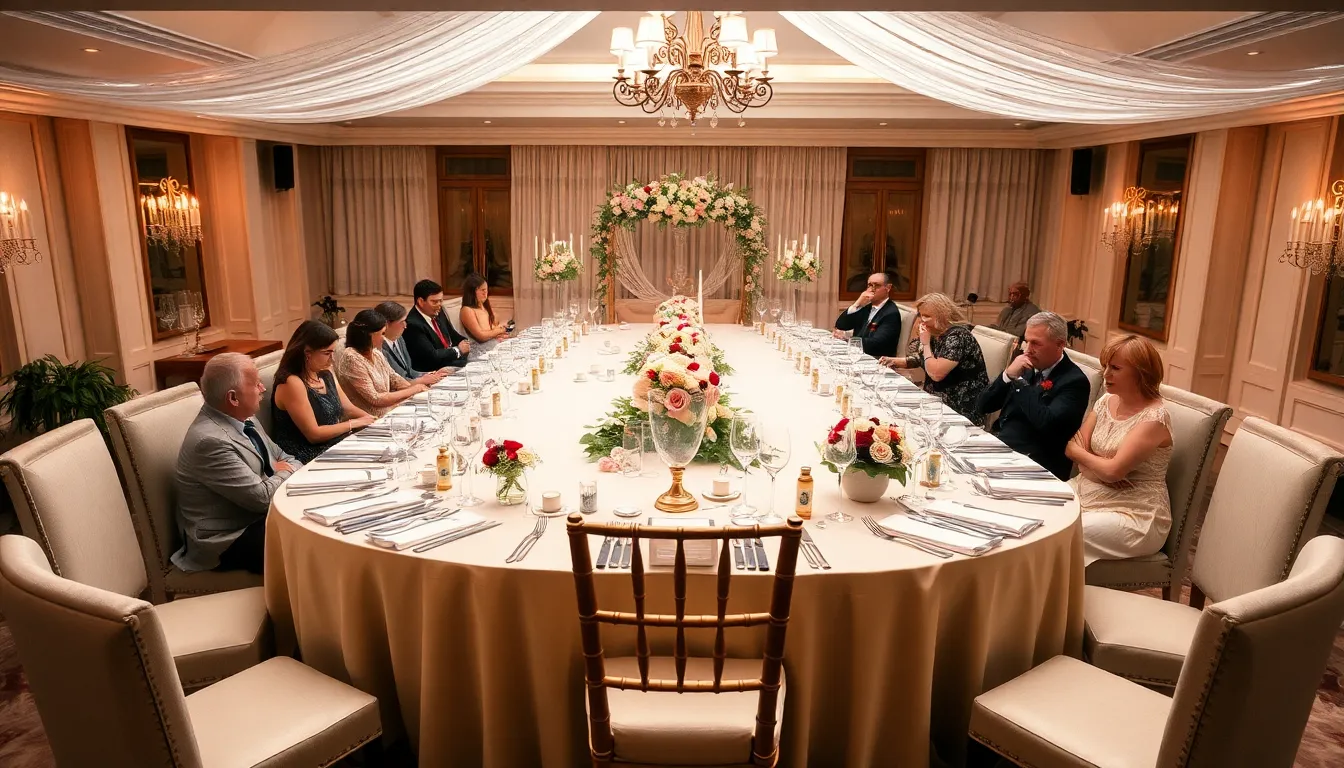
We recommend U-shaped table arrangements when you want to foster connection while maintaining elegance in your wedding reception layout.
Traditional U-Shape Setup Benefits
Traditional U-shaped setups excel at creating intimate dining experiences for medium-sized celebrations. We find this configuration works perfectly for 20-40 guests, striking the ideal balance between cozy conversation and spacious comfort. Guests can easily see and interact with each other across the arrangement, eliminating the isolation that sometimes occurs with scattered round tables.
Interactive conversations flow naturally when everyone faces toward the center of the U formation. The open end creates a perfect focal point for your sweetheart table or important moments like speeches and toasts. We love how this layout makes every guest feel included in the celebration rather than sitting on the sidelines.
Visual appeal increases dramatically with U-shaped arrangements since they create clean sight lines throughout the space. Your photographer will appreciate the unobstructed views for capturing candid moments and group shots during dinner service.
Modified U-Shape with Head Table
Modified U-shaped layouts with head tables amplify the traditional setup’s benefits while adding ceremonial importance to key moments. We suggest placing the head table at the open end of the U to ensure all guests have clear views of the wedding party during speeches.
Strategic positioning of the head table creates a natural theater-like atmosphere where important announcements and toasts become memorable performances. This configuration works exceptionally well when you want to honor parents, wedding parties, or special guests with prominent seating.
Enhanced focal points develop when the head table anchors the entire arrangement, drawing attention exactly where you want it throughout the reception. We’ve seen couples use this space for cake cutting ceremonies and other important moments that deserve everyone’s attention.
U-Shape Seating Chart Considerations
Strategic guest placement becomes crucial for maximizing the U-shaped layout’s interactive potential. We recommend positioning VIPs and key speakers at the base of the U to leverage the natural “head of the table effect” that commands attention.
| Seating Priority | Position | Guest Type |
|---|---|---|
| Highest | Base of U | VIPs, Key Speakers |
| High | Inner sides | Close family, Wedding party |
| Medium | Outer sides | Extended family, Close friends |
| Standard | Ends | General guests, Colleagues |
Secondary important guests should occupy the inner sides of the U formation, while extended family and friends fill the outer positions. This strategic arrangement ensures conversation flows from the most important relationships outward to newer connections.
Central space utilization offers unique opportunities for interactive elements like demonstration stations or display areas that engage all attendees simultaneously. We’ve successfully used this open area for live cooking demonstrations, wine tastings, and even small musical performances that complement the dining experience.
Square Table Layouts for Modern Wedding Aesthetics
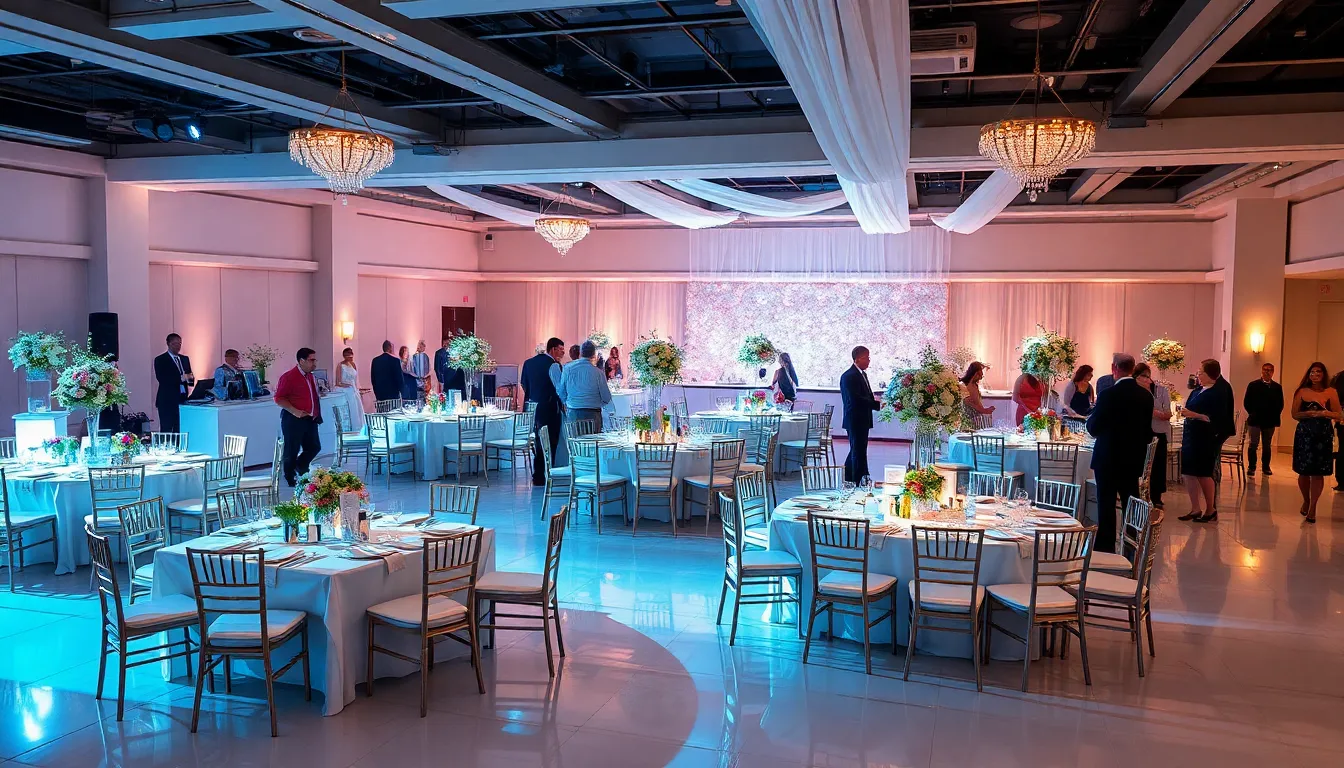
Square tables bring contemporary sophistication to wedding receptions while offering structured elegance that complements modern venue designs. We recommend these layouts for couples seeking distinctive alternatives to traditional round arrangements.
Geometric Square Table Patterns
Creating geometric patterns with square tables transforms your reception space into a visually striking experience. We suggest arranging square tables in clean grid formations to achieve a modern, structured aesthetic that guests will remember. Staggered layouts add visual interest while maintaining the contemporary feel that makes square tables so appealing for today’s weddings.
Large centerpieces become focal points when positioned on square tables, as these shapes provide ample surface area for luxurious decorative displays. Strategic placement allows each table to showcase unique floral arrangements or decorative elements that enhance the overall geometric design. Consider alternating centerpiece heights to create depth while maintaining the clean lines that define this modern approach.
Mixed Square and Round Combinations
Combining square and round tables creates ever-changing visual contrast that adds sophistication to your reception layout. We’ve found this approach particularly effective for couples who want to blend structured elements with the conversational flow that round tables naturally promote. Square tables work perfectly for VIP seating or family groups, while round tables encourage mingling among other guests.
Balance becomes key when mixing these table shapes, as the structured squares provide visual anchors while circular tables soften the overall aesthetic. Position square tables strategically near focal points like the sweetheart table or dance floor to create natural gathering spaces. This combination allows for diverse seating arrangements that accommodate different group sizes and social dynamics throughout your celebration.
Square Table Spacing Guidelines
Proper spacing between square tables ensures comfortable guest movement while maintaining an open, airy atmosphere in your reception area. We recommend maintaining 3-4 feet between tables to allow servers and guests to navigate easily without disrupting conversations. This spacing prevents the reception from feeling cramped while creating natural pathways for dancing and socializing.
Consider your venue’s layout when determining exact spacing, as architectural features like columns or stages may require adjustments to these guidelines. Traffic flow patterns should guide your spacing decisions, ensuring clear pathways to essential areas like the bar, restrooms, and dance floor. Adequate spacing also allows for easier chair placement and creates comfortable zones for photographers to capture candid moments throughout your reception.
Serpentine Table Designs for Unique Wedding Styles
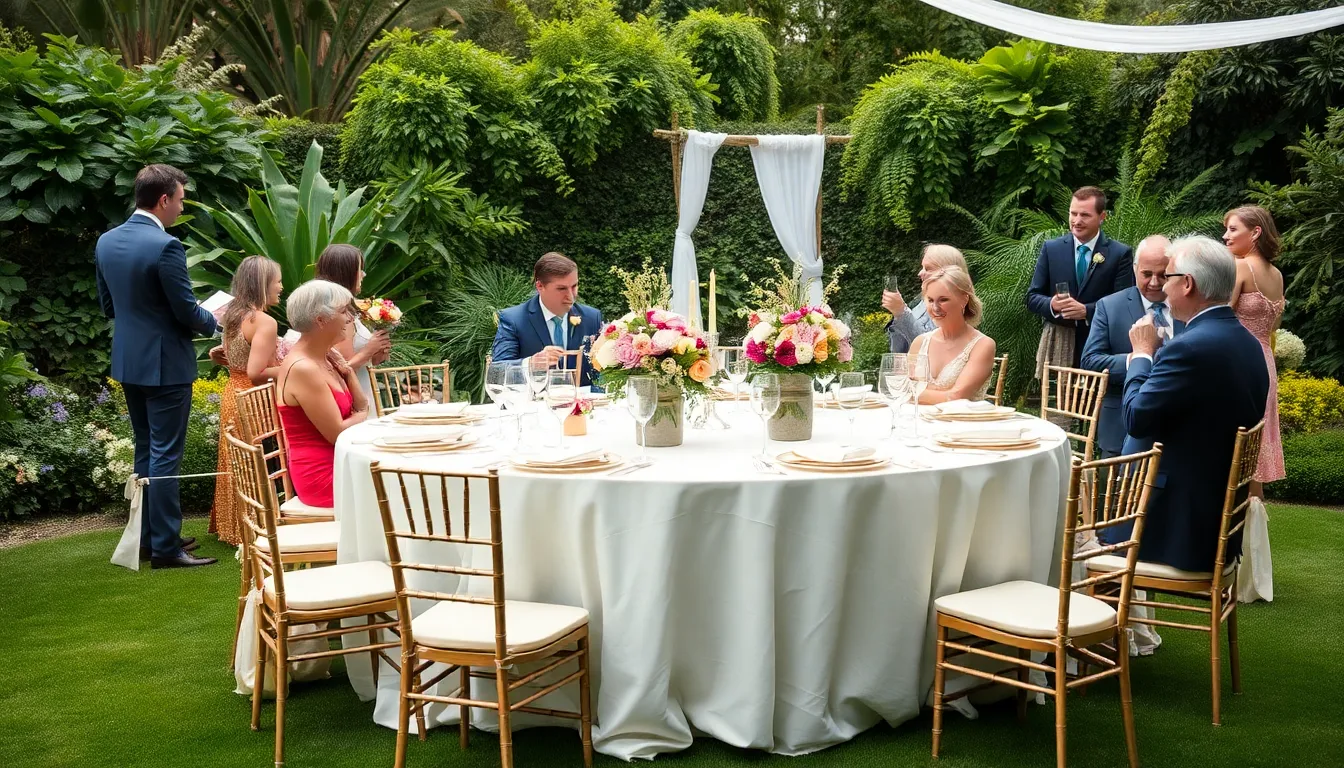
We recommend serpentine tables for couples seeking a modern and dramatic alternative to traditional round or rectangular layouts. These curved designs create visual interest while encouraging natural guest interaction throughout your reception space.
Curved Serpentine Table Flow
Curved serpentine tables measure approximately 30 inches wide and six feet long along their outer curve, creating a flowing arrangement that enhances your venue’s visual appeal. These tables naturally guide guests around the reception space, fostering a lively and interactive atmosphere that keeps conversations flowing seamlessly. We find them particularly effective in outdoor settings where the curved lines complement natural surroundings like gardens, courtyards, or vineyard terraces.
Positioning these tables allows for organic movement patterns, eliminating the rigid feeling that traditional straight arrangements can create. Guests can easily transition between conversations without feeling confined to one seating area. The flowing design works exceptionally well for venues with architectural curves or circular elements, as it echoes and enhances existing design features.
S-Shaped Table Arrangements
S-shaped tables offer a more defined twist and turn compared to gentle curved designs, creating distinct conversational zones within your reception space. We suggest using these arrangements to frame focal points like dance floors, stages, or ceremony backdrops while maintaining guest interaction opportunities. The pronounced curves allow you to create separate areas for different groups, such as family sections or friend circles, without completely isolating them from the broader celebration.
These arrangements work particularly well for medium to large weddings where you want to break up the space into more intimate sections. The S-shape naturally creates conversation pockets while maintaining sightlines across the entire reception area. We recommend placing key speakers or important family members at the curves’ focal points to ensure they remain central to the celebration’s energy.
Organic Curved Table Layouts
Organic curved layouts mimic natural flowing patterns with more fluid shapes than traditional serpentine designs, creating seamless integration with rustic or bohemian themed weddings. These arrangements blend beautifully into venues with natural elements like exposed beams, stone walls, or garden settings where rigid geometric patterns might feel out of place. We suggest decorating these tables with pastel colored linens and bouquets of pastel flowers for springtime elegance, or pairing white tablecloths with wood chairs and green centerpieces under romantic lighting for classic romance themes.
The organic approach allows for complete customization based on your venue’s unique features and guest count. Tables can curve around existing obstacles like pillars or trees, turning potential design challenges into integrated elements that enhance your overall aesthetic. This flexibility makes organic curved layouts ideal for non-traditional venues like barns, warehouses, or outdoor spaces where standard table arrangements might not fit the available footprint.
Mixed Table Shape Combinations for Dynamic Reception Spaces

We’ve explored individual table styles, but combining different shapes creates truly ever-changing reception spaces that captivate guests and maximize your venue’s potential.
Balancing Different Table Shapes
Symmetrical balance works beautifully when we place identical tables on either side of a central aisle while mixing shapes elsewhere to create harmony. Curved tables paired with U-shaped arrangements alongside round tables offer versatile seating that accommodates varying guest counts while maintaining visual interest.
Asymmetrical arrangements become stunning focal points through strategic placement of rectangular and square tables mixed with round ones. This flexibility proves particularly effective in larger venues where we need to work around architectural features like columns or stages.
Visual hierarchy emerges naturally when we use different table shapes to draw attention to exact reception areas. Round tables for intimate family groups can surround a dramatic rectangular head table, while square tables near the dance floor create modern sophistication that complements the overall design.
Creating Visual Zones with Mixed Layouts
Dining and social separation becomes effortless when we designate round tables for intimate dining experiences while using rectangular tables for socializing and mingling. These distinct zones help guests naturally transition between formal dining and casual conversation throughout the evening.
Special event areas gain prominence through unique table shapes that visually distinguish them from the main dining space. Square tables positioned near photo booths or dessert stations create defined spaces that encourage guest interaction without disrupting the primary reception flow.
Conversation clusters form organically when we alternate table shapes throughout the space. Mixing curved tables with traditional rounds creates natural gathering points that encourage guests to move between different social groups during cocktail hour and dancing.
Traffic Flow with Multiple Table Types
Aisle width planning becomes critical when mixing table shapes and sizes to prevent congestion and ensure comfortable movement. We recommend maintaining wider pathways between different shaped tables since guests need extra space to navigate around varying table edges and chair placements.
Strategic entry and exit positioning guides guests efficiently through reception areas while minimizing bottlenecks at key transition points. Placing rectangular tables near entrances creates natural gathering spaces, while round tables deeper in the venue provide intimate dining experiences away from high traffic areas.
Service accessibility requires careful consideration when combining multiple table types since servers need clear pathways to reach every guest. We suggest creating service corridors between different table zones to ensure smooth food delivery and efficient cleanup without disrupting guest enjoyment.
Outdoor Wedding Table Layout Considerations
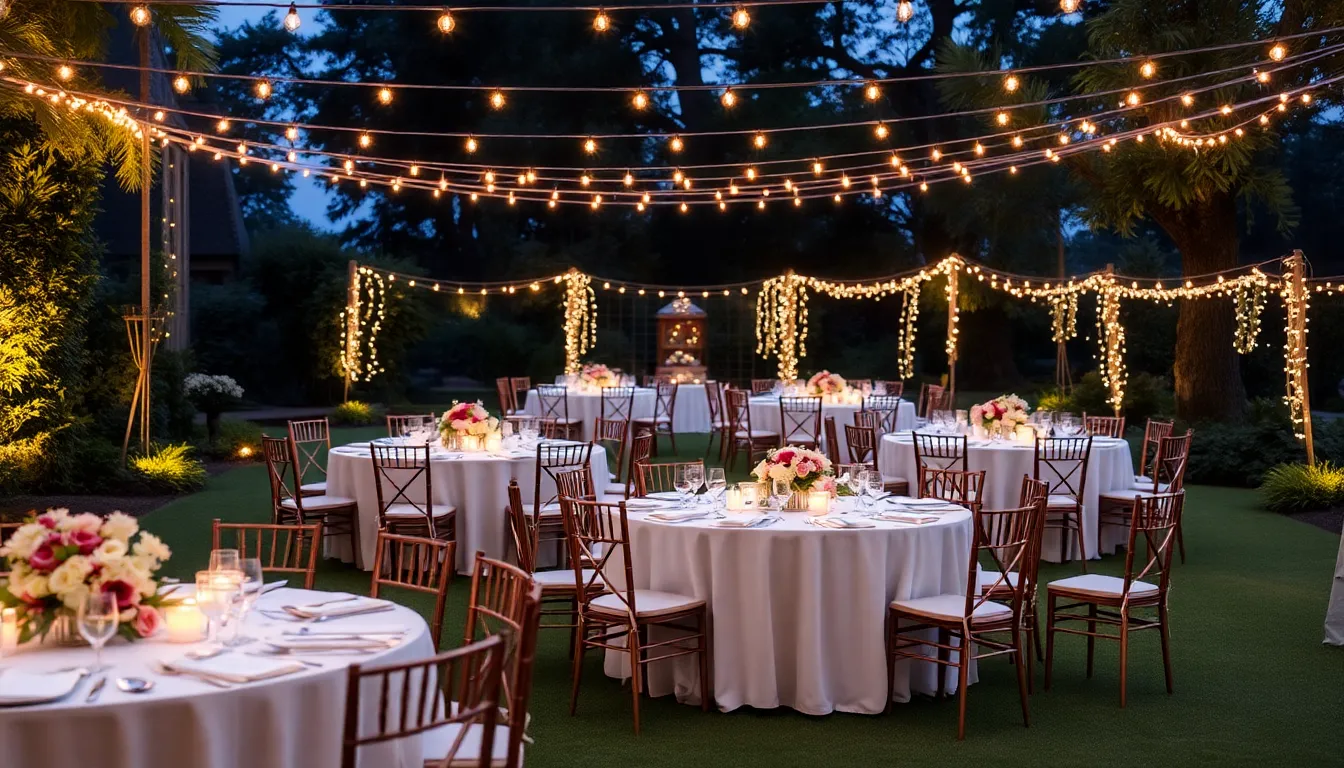
Outdoor venues present unique opportunities to create breathtaking table arrangements that complement natural surroundings. We’ll guide you through the most effective layouts for different outdoor wedding settings that maximize both visual appeal and guest comfort.
Garden Party Scattered Table Arrangements
Garden settings call for relaxed table placements that embrace the natural industry’s organic beauty. We recommend positioning round tables throughout the garden space to create intimate conversation pockets while allowing guests to mingle freely between dining areas. Mix 48-inch round tables for 6 guests with 60-inch tables for 8 guests to establish varying group sizes that encourage natural social interaction.
Position tables strategically around existing garden features like flower beds, fountains, or mature trees to highlight the venue’s natural charm. Create clear pathways between table clusters using stone walkways or temporary flooring to ensure comfortable movement in heels and formal attire. Small seasonal floral centerpieces work best in garden settings, keeping arrangements low enough to maintain conversation flow while complementing the surrounding blooms.
Fairy light centerpieces add magical ambiance as daylight fades, creating a whimsical atmosphere that transforms the garden into an enchanted dining space. String lights between trees or install temporary lighting poles to illuminate pathways and create a warm, inviting glow throughout the reception area.
Beachside Linear Table Setups
Beachfront venues demand linear table arrangements that maximize stunning ocean views for every guest. We suggest positioning long rectangular tables parallel to the shoreline, creating unobstructed sightlines to the water while maintaining an elegant dining experience. This linear approach also helps protect against ocean breezes by creating natural windbreaks between table rows.
Space tables 8-10 feet apart to accommodate service staff and guest movement while preventing sand from disrupting the dining experience. Use nautical themed centerpieces featuring shells, driftwood, or coral elements that complement the coastal setting without competing with the natural ocean view.
Prioritize guest comfort with soft cushions on chairs and strategic shade placement using umbrellas or temporary canopies. Position the head table or sweetheart table slightly elevated on a platform to ensure visibility from all angles while maintaining the linear flow of the overall layout.
Backyard Wedding Flexible Layouts
Backyard celebrations offer the ultimate flexibility to customize table arrangements based on available space and guest preferences. We recommend mixing table shapes and sizes to create ever-changing visual interest while accommodating the intimate nature of home celebrations. Combine 60-inch round tables with 8-foot rectangular tables to establish different dining experiences within the same space.
Create cozy conversation nooks using existing industry features or temporary decorative screens that provide privacy without isolating guests from the main celebration. Position larger round tables near the house for older family members who may need easier access to indoor facilities, while placing rectangular tables in more open areas for younger guests who prefer communal dining.
String lights or paper lanterns transform backyard spaces into magical evening venues, creating warm ambiance that extends the celebration well into the night. Use the home’s architectural features like porches, decks, or garden structures as natural focal points that anchor the table layout and create cohesive flow throughout the reception area.
Small Wedding Table Layout Solutions

When you’re planning an intimate celebration, we know how important it’s to create layouts that maximize connection while maintaining elegance throughout your reception space.
Intimate Circle Arrangements
Circle arrangements work exceptionally well for fostering meaningful conversations among your closest loved ones. We recommend round tables as they naturally seat guests face to face, making personal interactions effortless and creating an atmosphere of warmth that encourages deeper connections.
Combining round tables with other geometric shapes allows us to optimize your venue’s unique dimensions while ensuring every guest feels comfortable and included. This flexibility proves especially valuable in irregularly shaped spaces where traditional layouts might feel forced or awkward.
Strategic positioning of round tables throughout your reception area creates natural conversation pods that encourage mingling between different groups. We’ve found that this organic flow helps break down social barriers and ensures no guest feels isolated during your celebration.
Family Style Single Table Options
Single long rectangular tables transform your reception into an elegant banquet style gathering that emphasizes closeness and shared experiences. We love how this layout allows all guests to share dishes communally, creating a homey atmosphere that promotes natural interaction and conversation flow.
Long table configurations work beautifully for close knit groups who want to maintain visual connection throughout the entire meal service. This setup eliminates the separation that multiple tables can create, ensuring everyone feels part of one unified celebration.
Royal touches like elegant table runners and strategic centerpiece placement can transform a simple long table into a sophisticated focal point. We recommend spacing decorative elements to allow for easy conversation across the table while maintaining the grandeur of your design vision.
Cozy Cluster Table Groupings
Cluster groupings involve arranging several small tables in close proximity to create intimate dining pods throughout your reception space. We find that mixing round and rectangular tables within these clusters provides visual interest while accommodating different group dynamics and conversation styles.
Flexible cluster arrangements adapt beautifully to irregular venue shapes and architectural features that might challenge traditional layout options. This approach balances openness with intimacy, allowing guests to feel connected to the larger celebration while enjoying cozy conversations within their smaller groups.
Strategic spacing between clusters ensures easy movement for both guests and service staff while maintaining the intimate atmosphere you’re seeking. We recommend positioning clusters to create natural pathways that guide guests toward key areas like the dance floor or bar service stations.
Large Wedding Reception Table Organization

Planning table layouts for large wedding receptions requires strategic thinking to ensure every guest feels included while maintaining elegant flow throughout your celebration.
Grand Ballroom Layout Strategies
Symmetrical arrangements create visual balance and sophisticated elegance in grand ballroom settings. We recommend positioning your head table centrally to serve as the focal point, drawing attention during key moments like speeches and toasts. Round tables clustered around this central point maintain timeless charm while ensuring guests can easily view important ceremonies.
Mixed table shapes add ever-changing visual interest to expansive ballroom spaces. Combining round, rectangular, curved, and square tables creates a creative layout that prevents monotony while maintaining cohesive design. This versatile approach allows you to accommodate different group sizes naturally.
Clear aisleways become essential pathways for smooth guest movement throughout large ballrooms. Designating these walkways prevents bottlenecks during transitions between dinner service, dancing, and mingling. Strategic spacing ensures servers can navigate efficiently while guests move comfortably between tables and entertainment areas.
Long rectangular tables introduce elegant community dining that encourages conversation across your entire guest list. These arrangements work particularly well in ballrooms with high ceilings, creating dramatic sight lines that complement architectural grandeur.
Multiple Dining Room Coordination
Unified themes maintain cohesion across separate dining spaces without sacrificing individual room character. We suggest using consistent color palettes, centerpiece styles, and lighting approaches while adapting table arrangements to each room’s unique dimensions and features.
Seating capacity calculations prevent overcrowding in each designated dining area. Proper planning ensures comfortable movement between tables while maintaining intimate conversation opportunities. Calculate approximately 10 square feet per guest to determine optimal table placement in each room.
Strategic buffet station placement manages guest flow effectively across multiple dining areas. Position serving stations to distribute crowds evenly, reducing congestion in popular areas while ensuring equal access for all guests regardless of their dining room assignment.
Managing Guest Flow in Large Spaces
Clear pathway designation prevents bottlenecks during peak movement times like cocktail hour transitions and dancing breaks. We recommend creating buffer zones around high traffic areas such as bars, restrooms, and dance floors to manage crowd buildup naturally.
Directional signage guides guests smoothly between different reception areas without confusion. Strategic placement of elegant signs helps guests locate bars, restrooms, and special activity zones while maintaining your wedding’s aesthetic appeal.
Traffic flow planning considers natural movement patterns throughout your reception timeline. Position popular gathering spots like photo booths and dessert stations away from main dining areas to encourage exploration while preventing congestion during meal service.
Conclusion
Your wedding table layout sets the foundation for unforgettable memories and meaningful connections. We’ve explored everything from intimate round arrangements to dramatic serpentine designs that transform your reception space into something truly special.
The key to success lies in matching your chosen layout to your guest count venue characteristics and celebration style. Whether you’re planning an elegant ballroom affair or a cozy garden gathering the right table arrangement ensures every guest feels welcomed and engaged.
Remember that thoughtful spacing strategic guest placement and clear traffic flow are just as important as the table shapes themselves. These elements work together to create seamless service and comfortable movement throughout your reception.
Take time to visualize how your chosen layout will enhance conversation encourage mingling and complement your venue’s unique features. With careful planning your table arrangement will become the perfect backdrop for celebrating your new beginning.
Frequently Asked Questions
What is the best table shape for encouraging guest conversation at a wedding reception?
Round tables are considered the best for fostering conversation as they create intimate circles where all guests can easily see and speak with each other. The curved seating arrangement naturally encourages interaction and helps break down social barriers, making them ideal for mixing different groups of guests.
How many guests should I seat at a 60-inch round table?
A standard 60-inch round table comfortably accommodates 8-10 guests. This capacity maintains intimacy while ensuring everyone has adequate space. Seating 8 guests provides more elbow room, while 10 creates a cozier atmosphere but may feel slightly crowded depending on your venue and guest preferences.
What are the advantages of long banquet-style tables for wedding receptions?
Long banquet tables create an elegant dining experience that transforms your reception space and encourages conversation along the table’s length. They’re perfect for smaller weddings under 40 guests, foster closeness, and provide impressive opportunities for dramatic centerpiece displays and decorative arrangements.
When should I consider a U-shaped table arrangement?
U-shaped arrangements work best for medium-sized celebrations of 20-40 guests. This layout allows intimate dining where all guests can see each other, with the open end serving as a focal point for speeches and toasts. It ensures everyone feels included in key moments.
How do square tables differ from round tables in wedding receptions?
Square tables offer contemporary sophistication and structured elegance that complements modern venue designs. They create geometric patterns and showcase large centerpieces effectively. However, they may be less conducive to cross-table conversation compared to round tables’ natural flow.
What is the benefit of mixing different table shapes at a wedding reception?
Mixing table shapes creates dynamic, visually interesting reception spaces that captivate guests. It allows you to create distinct zones for dining and socializing while accommodating different group sizes. This approach adds visual contrast and can better utilize your venue’s unique layout.
How should I plan table layouts for large weddings?
For large weddings, use symmetrical arrangements in grand spaces, position the head table centrally, and create clear aisleways for smooth guest movement. Mix table shapes for visual interest, ensure proper spacing between tables, and plan traffic flow with directional signage to enhance the overall experience.
What table layout works best for small intimate weddings?
Small weddings benefit from cozy cluster arrangements or single long tables that maximize connection. Family-style seating creates a homey atmosphere, while strategically spaced intimate groupings maintain elegance. Focus on creating warm, conversational environments where every guest feels included and connected.

